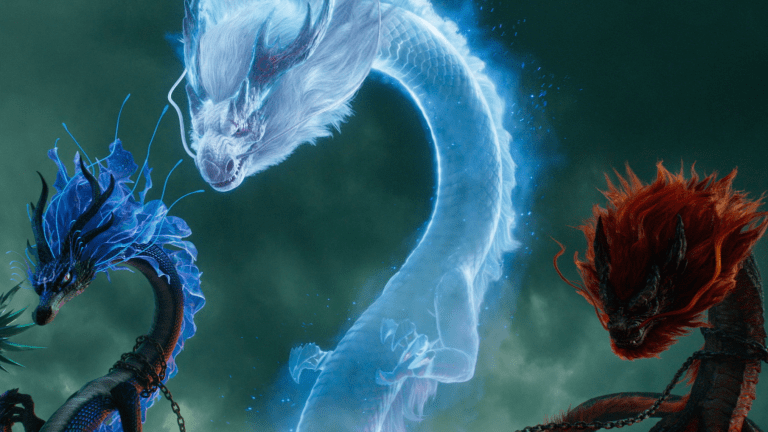Ne Zha 2: The Real Lore Behind the Biggest Movie of 2025 (and Why You Haven’t Heard of It)
Chinese film Ne Zha 2 is about to get its second American release while on its way to outgrossing Titanic. If you haven't heard about it, it's time to find out why this story is already the stuff of legend.

Last February, and at the start of the Chinese New Year, a movie called Ne Zha 2 came to theaters around the world, including a relatively small handful of screens in the U.S. Since then it has earned more than $2.1 billion globally. For context, that makes it not only the biggest movie of the year, but also a higher grosser than Star Wars: The Force Awakens. Made in China, it is the only non-Hollywood film in the top 50 highest grossing films of all time. Meanwhile this year’s next highest earner, Lilo & Stitch, is trailing behind by $1.1 billion. If Ne Zha 2 grosses about another $50 million, it will unseat Titanic as the fourth highest grossing film ever.
It has a good shot at sinking Titanic too. The original Chinese New Year release was distributed internationally, but only as a subtitled Mandarin-language film. However, a new English-language dubbed version is coming out this week, distributed by indie tastemaker studio A24. This re-release also adds international star power with Michelle Yeoh voices Ne Zha’s mother, Lady Yin in English. China is likewise backing the dubbed release with a massive, big-budget advertising campaign on TV and social media platforms like YouTube and TikTok, which is especially targeting non-Chinese audiences.
When the year ends, Ne Zha 2 might just be among the five biggest movies ever. And yet, we imagine more than a few Western readers could be asking themselves right now… what is Ne Zha? Well, believe it or not, it begins a lot further back than the 2019 Chinese film of the same name.
The Legend of the Third Lotus Prince
Everyone in China knows about Ne Zha. He is mischievous child with godlike powers from the 16th century novel Investiture of the Gods (Fengshen Yanyi) by Xu Zhonglin. This classic is a fantastic chronicle of the fall of the Shang Dynasty (1600–1046 BCE) and the rise of the Zhou Dynasty (1046–256 BCE). Like Homer’s The Iliad and Odyssey, the affairs of deities affect the course of humankind in this story. There’s a comic book quality to the epic too; and it’s one that has stood the test of time. Imagine what the stories from DC or Marvel might become after being passed down for three more centuries. Investiture of the Gods is akin to that.
Among the many heroes of Investiture of the Gods, Ne Zha (pronounced ‘Nuh-jah,’) is a fan favorite. His story has been retold many times in film, literature, television, comics, traditional opera, and even puppet shows. He’s a conflicted character who straddles the line between deity and demon, usually wreaking havoc while trying to do the right thing. Like a superhero, Ne Zha has magic powers and weapons. He can fly using his Wind Fire Wheels, which are like flaming roller skates, and he wears a magic red sash that is akin to Doctor Strange’s Cloak of Levitation. He is also armed with two magic weapons, his Fire-tipped Spear and his Universe Ring. Ne Zha bears the honorific titles of “Marshal of the Central Altar” and the “Third Lotus Prince.” However, his most beloved incarnation is that of a prankster brat.
A Visual Feast
Simply put Ne Zha 2 is a visual feast like nothing that has come before. It’s funny and heartfelt with moments ranging from puerile pee jokes to heart wrenching mother and son relationships, embedded in gripping action scenes. The siege of Chentang Pass by the demon horde is such a massive sequence, a glorious triumph of modern animation, and the rest of the film is filled with similarly detailed, insane imagery—visions of universes getting ripped open, powerful immortals, monstrous beasts and dragons, and cosmic battles of cataclysmic proportions.
Its imaginative vision is groundbreaking and unparalleled, which is why it has succeeded so well at the global box office despite being extracted from a chapter in Chinese culture that isn’t that well known internationally. But the world knows Ne Zha now. Ne Zha 2 is a big screen experience, one that is designed for premium formats like 3D and IMAX. Don’t cheat yourself. Treat yourself. See Ne Zha 2 in a theater on the biggest screen you can find.
Just like with the MCU or DC Universe, those familiar with Investiture of the Gods know Ne Zha’s story (and argue at length about where Ne Zha 2 strays from canon). For the uninitiated, there’s a lot of backstory, but don’t worry. Audiences around the world have been swept up by the fresh spectacle of Ne Zha 2 without all that background baggage. You don’t even have to see the first film, 2019’s Ne Zha, before diving in.
Still, it would help to know that Ne Zha 2 is the direct sequel to that movie, picking up immediately from where the first film left off. The 2019 picture is Ne Zha’s creation story, but all is explained well enough in Ne Zha 2. The first Ne Zha was also a blockbuster in China, and while it is a good film it is Ne Zha 2 that truly levels up as both a narrative and spectacle, catapulting the franchise into something revolutionary. It’s in fact better to view Ne Zha as the prequel to Ne Zha 2 instead of Ne Zha 2 as a sequel. This is the main event.
The Fengshen Universe
In 2019 Ne Zha was the debut film for writer-director Jiaozi (like Madonna or Beyonce, he goes by only one name). Remarkably Ne Zha 2 is merely his second feature-length film. However, the Ne Zha films are part of the growing animated Fengshen Universe from Beijing Enlight Pictures, one of the top three privately held film companies in China.
Another film was squeezed in between the Ne Zha films. Jiang Ziya, which came out in 2020. The title comes from another hero in Investiture of the Gods. Written by Xie Xiying and directed by Cheng Teng and Li Wei, Jiang Ziya has a different style of animation that is not nearly as eye-popping, and even strays from how the Ne Zha films depict some of the overlapping characters from the novel. While Jiang Ziya has its moments, it hardly compares to the Ne Zha films in scope, storytelling, or animation.
Even so, Ne Zha appears in a cameo role during a mid-credit scene exactly how he is depicted in his own films, solidifying the Fengshen Universe connection. Similarly Jiang Ziya appears in a mid-credit scene in Ne Zha 2 (which is a little anachronistic since the events in the Ne Zha films take place half a century before Jiang Ziya). What’s next for the Fengshen Universe remains to be seen. There’s plenty of material within Investiture of the Gods for more and there’s no doubt that Beijing Enlight Pictures will do a Ne Zha 3, but an official launch of production has yet to occur.
Beijing Enlight Pictures produces both animated and live action films. In 2023 it produced Deep Sea, a critically acclaimed animated fantasy film that had nothing to do with the Fengshen Universe. There are also two other projects in development: a remake of The Shaolin Temple (1982), the debut film of Jet Li, to be directed by Justin Lin, and a new version of Black Jack, a Japanese manga from the ‘70s that has already been made into movies and TV series several times over.
Coincidentally, another major Chinese animation company is mining Investiture of the Gods for content. Light Chaser Animation Studios has been creating their New Gods cinematic universe, and it’s already five films deep. The franchise officially launched with the second film New Gods: Nezha Reborn in 2021. This is also a retelling of Ne Zha, however it’s set in a cyberpunk future. The New Gods cinematic universe also includes New Gods: Yang Jian (2022) and serpentining in between are three films about Lady White Snake, which is based on a folktale that stands outside of Investiture of the Gods, but like with Ne Zha and Jiang Ziya, the characters appear in cameos in each other’s films.
Last July Light Chaser Animation Studios also released Curious Tales of a Temple, which is based on the 17th century novel Strange Tales from a Chinese Studio by Pu Songling, however it is unclear whether or not this will fall under the New Gods Universe.
Don’t Call It ‘Anime.’ This is Donghua
Westerners have coined the term anime for Japanese animation (however in Japanese, anime refers to all animation, not just projects coming from Japan). Chinese animation, by contrast, has its own Mandarin term, donghua, which literally means “moving picture.” Remember that term. Ne Zha 2 is the vanguard of a new wave of Chinese animation, of donghua. And Chinese donghua is on the rise.
The English dubbed version of Ne Zha 2 will open in select theaters on Aug. 22, 2025 in IMAX, 3D and other premium large formats.

